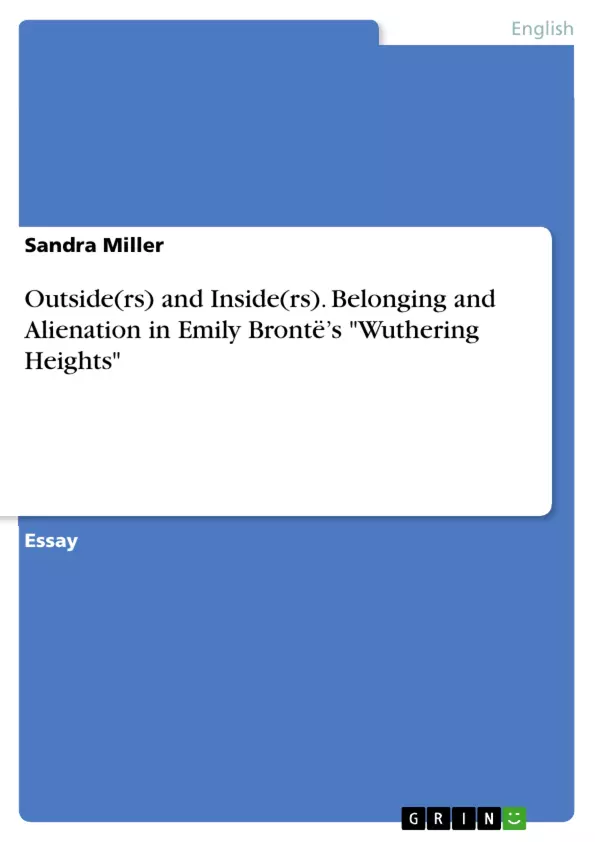Man-made barriers such as windows, doorways and fences, and the harsh nature of the Yorkshire moors are presented as physical boundaries that delineate the state of being ‘inside’ or ‘outside’, which is indicative of the characters’ status: whether they inhabit their respective environments as either ‘insiders’ or ‘outsiders’. Symbolically, these thresholds between ‘culture’ and ‘nature’ separate different ways of life.
The people and the landscape in which they live are set in stark contrast: conventional gentile civilisation against the actions of the elements, the forces of the natural world. Brontë applies boundaries to show the conflicting states of attraction and repulsion that make up the drama – the story of two families caught in a feud. The main characters are caught in a struggle either to overcome their alienation in a particular setting or to escape from a forced inclusion: the child Heathcliff suffers from being excluded from the Earnshaw family as an unwelcomed outsider; as an adult, he will spend his life taking revenge on the ones that once mistreated and deprived him of his position. Isabella Linton rushes into a miserable marriage with Heathcliff and becomes his prisoner at the Heights until she manages to escape. Cathy Earnshaw is much closer to Heathcliff than to her brother Hindley; they are soulmates, inseparable and tied by a spiritual bond that transcends time and place. Their relationship is tempestuous but exclusive. When Cathy accepts Edgars' proposal, she chooses the cultured life and thereby voluntarily removes herself from the influence of her family and Heathcliff. Once inside the Grange, she soon realizes that she has lost her freedom as well as her place at the Heights.
Inhaltsverzeichnis (Table of Contents)
- INTRODUCTION
- The Symbolic Value of Boundaries
- The Narrators
- The Grange and Wuthering Heights
- Outsiders and Insiders
- The Role of Windows
- Cathy's Struggle for Freedom
- Heathcliff's Rejection of Domesticity
Zielsetzung und Themenschwerpunkte (Objectives and Key Themes)
This text aims to analyze the concepts of belonging and alienation in Emily Brontë's Wuthering Heights, focusing on the symbolic value of boundaries, the dynamics between insiders and outsiders, and the characters' struggles for freedom and belonging within a confined world.
- The symbolic significance of physical and psychological boundaries in the novel.
- The contrasting worldviews and social values of the Earnshaw and Linton families.
- The characters' experiences of alienation and their attempts to overcome it.
- The impact of external forces on the characters' lives and relationships.
- The nature of love, desire, and revenge in the context of the novel.
Zusammenfassung der Kapitel (Chapter Summaries)
The text begins by exploring the symbolic value of boundaries in Wuthering Heights, using examples such as windows, doors, and fences. It then introduces the main narrators, Mr. Lockwood and Nelly Dean, whose perspectives provide insight into the story.
The text goes on to analyze the contrasting settings of Wuthering Heights and Thrushcross Grange, which represent distinct social values and ways of life. It discusses the roles of outsiders and insiders in the story, highlighting the experience of alienation faced by characters like Heathcliff and Isabella.
The text further explores the symbolic value of windows as thresholds between different realities, and examines Cathy's internal struggle for freedom and belonging. Finally, it analyzes Heathcliff's rejection of domesticity and the destructive nature of his revenge.
Schlüsselwörter (Keywords)
The key terms and concepts explored in this text include: belonging, alienation, boundaries, insiders, outsiders, social class, love, desire, revenge, freedom, domesticity, nature, culture, Gothic, symbolism, narrative perspective.
- Quote paper
- Sandra Miller (Author), 2004, Outside(rs) and Inside(rs). Belonging and Alienation in Emily Brontë’s "Wuthering Heights", Munich, GRIN Verlag, https://www.grin.com/document/293312



